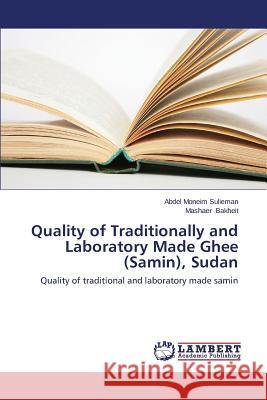Quality of Traditionally and Laboratory Made Ghee (Samin), Sudan » książka
Quality of Traditionally and Laboratory Made Ghee (Samin), Sudan
ISBN-13: 9783659531361 / Angielski / Miękka / 2014 / 80 str.
Samin is traditional cooking oil in Sudan and most common in North African and Middle Eastern countries. It is produced using the butter made from the milk of sheep, cow or goats. The objectives of the study was determination of the physical, chemical and sensory characteristics of samin samples collected from local market, preparation of Samin at the laboratory level and evaluation its quality. The moisture content ranged between 0.08 +0.06 and 0.34+0.05%, however, the acid value, free fatty acids, peroxide value, saponification value, density, viscosity, melting point and refractive index ranged between 0.56 0.0 to 1.94 0.17 (mgKOH/g), 0.28 0.0 to 0.97 0.09%, 9.87 0.31, to 2.60 0.0, (mEq/kg), 172.23 to 163.81(mgKOH/g), 0.925to 0.909, g/cm and 0.551x10 3 0.0 0.0 to 0.307x10 3 0.0, pa.s, melting points were 38 to 37, and 1.4600, to 1.4590, 1.4598, respectively. Sensory evaluation revealed no-significant differences in texture, color, and overall acceptability of the samples but there was significant difference (p 0.05) in flavor, between LMS sample and the other samples. It is highly recommended to improve preparation under controlled hygienic conditions."
Samin is traditional cooking oil in Sudan and most common in North African and Middle Eastern countries. It is produced using the butter made from the milk of sheep , cow or goats. The objectives of the study was determination of the physical, chemical and sensory characteristics of samin samples collected from local market, preparation of Samin at the laboratory level and evaluation its quality. The moisture content ranged between 0.08 +0.06 and 0.34+0.05%, however, the acid value, free fatty acids, peroxide value, saponification value, density, viscosity, melting point and refractive index ranged between 0.56 ± 0.0 to 1.94±0.17 (mgKOH/g), 0.28 ± 0.0 to 0.97±0.09%, 9.87 ± 0.31, to 2.60 ± 0.0, (mEq/kg), 172.23 to 163.81(mgKOH/g), 0.925to 0.909, g/cm³ and 0.551×10−3±0.0 ±0.0 to 0.307×10−3±0.0, pa.s, melting points were 38 to 37 Ċ, and 1.4600, to 1.4590, 1.4598 , respectively. Sensory evaluation revealed no-significant differences in texture, color, and overall acceptability of the samples but there was significant difference (p ≤ 0.05) in flavor, between LMS sample and the other samples. It is highly recommended to improve preparation under controlled hygienic conditions.











